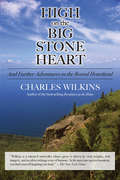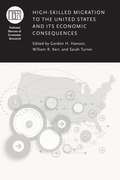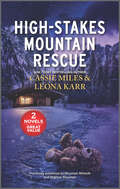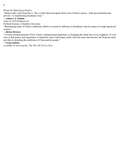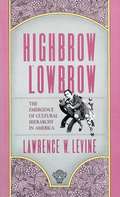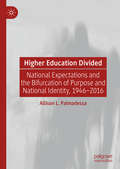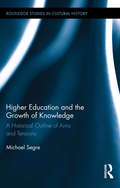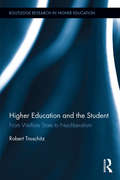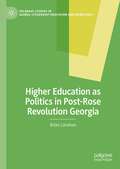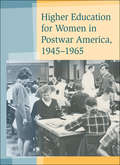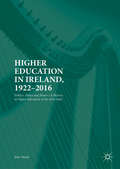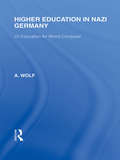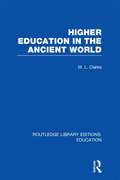- Table View
- List View
High on a Hill (Jazz Age #2)
by Dorothy GarlockFrom the bestselling author of "The Edge of Town" comes a novel about a young girl who must choose between a bootlegging father and the lawman on his trail.
High on the Big Stone Heart: And Further Adventures in the Boreal Heartland
by Charles WilkinsHigh on the Big Stone Heart is a collection of vibrant and entertaining essays on the people and places of Canada’s Boreal North as seen through the eyes of one of the country’s most celebrated writers of non-fiction. Accompany Charles Wilkins as he ranges across the wilds of northern Quebec; ventures deep into the subarctic Yukon in search of caribou; and tracks the north coast of Lake Superior, the world’s most elegant and mysterious body of fresh water. Meet Murray Monk, trapper extraordinaire, and Barney Giesler, the king of the wooden boat builders. Trace the route of the Toronto Maple Leafs’ Bill Barilko, star of the 1951 Stanley Cup Final, on his last and fatal fishing trip to James Bay. Join Maurice "Rocket" Richard on the backwoods adventures that sustained him throughout his troubled career. Follow Wilkins himself as he embarks on a wilderness survival test with nothing but the clothes on his back. This is a book for anyone drawn to the magic of the North, and by the characters who inhabit that epic terrain.
High, Low and Wide Open
by James R. FrancisHigh, Low and Wide Open, first published in 1935, is an early noir novel of the rough and tumble life in a western mining camp. As the dustjacket states: “Murder and violence are in it, but it is no mere thriller; it will puzzle and keep the reader in suspense, but it is not a mystery-story; it contains profane love and language, yet is not a shocker. Basically, it is a terse, swift, and grim chronicle of how love, hate, lust and greed drive all too human men and women to desperate and devious ways. The descriptions of that colorful and unique town, Perch, the greatest mining camp in the world, of its homes, brothels, saloons, and gambling joints; of its strange ways of justice, all are fascinating. The speech, the customs, the very thoughts of the minor characters, the casually heroic miners who toil in the back depths of the richest hill on earth, are authentic. The author was born in a mining camp, and mucked ore 3,600 feet underground. From the unforgettable opening scene to the exciting and unexpected climax, the story leaps forward with the speed and remorselessness of the spring of a puma.”
High, Wide and Frightened
by Louise ThadenHigh, Wide and Frightened, first published in 1938, is pioneering aviator Louise Thaden's account of her adventures in the early days of flying. Thaden (1905-1979) earned her pilot's certificate in 1928 and would go on to win numerous long-distance air-races, and set numerous records for high-elevation and long-endurance flights. This edition includes the chapter entitled "Noble Experiment," (omitted from later reissues of the book), which describes Thaden's vision on the use of women in combat. In the final chapter of the book, Thaden describes her friendship with Amelia Earhart, who disappeared in 1937 over the Pacific Ocean.
High-Risers: Cabrini-Green and the Fate of American Public Housing
by Ben AustenA Booklist Best Book of the Year: “The definitive history of the life and death of America’s most iconic housing project,” Chicago’s Cabrini-Green (David Simon, creator of The Wire).Built in the 1940s atop an infamous Italian slum, Cabrini-Green grew to twenty-three towers and a population of 20,000—all of it packed onto just seventy acres a few blocks from Chicago’s ritzy Gold Coast. Eventually, Cabrini-Green became synonymous with crime, squalor, and the failure of government. For the many who lived there, it was also a much-needed resource—it was home. By 2011, every high-rise had been razed, the island of black poverty engulfed by the white affluence around it, the families dispersed.In this novelistic and eye-opening narrative, Ben Austen tells the story of America’s public housing experiment and the changing fortunes of American cities. It is an account told movingly though the lives of residents who struggled to make a home for their families as powerful forces converged to accelerate the housing complex’s demise. Beautifully written, rich in detail, and full of moving portraits, High-Risers is a sweeping exploration of race, class, popular culture, and politics in modern America that brilliantly considers what went wrong in our nation’s effort to provide affordable housing to the poor—and what we can learn from those mistakes.“Compelling.” —Chicago Tribune“[A] fascinating narrative.” —Booklist (starred review)“A weighty and robust history of a people disappeared from their own community.” —Kirkus Reviews“Austen has masterfully woven together these deeply intimate stories of the residents at Cabrini against the backdrop of critical public policy decisions. Ultimately this book is about how as a country we acknowledge and deal with the very poor.” —Alex Kotlowitz, author of There Are No Children HereNamed a Best Book of the Year by Mother JonesNominated for the Andrew Carnegie Medal of Excellence in Nonfiction; the Goddard Riverside Stephan Russo Book Prize; and the Chicago Review of Books Award
High-Skilled Migration to the United States and Its Economic Consequences (National Bureau of Economic Research Conference Report)
by Gordon H. Hanson, William R. Kerr, and Sarah TurnerImmigration policy is one of the most contentious public policy issues in the United States today. High-skilled immigrants represent an increasing share of the U.S. workforce, particularly in science and engineering fields. These immigrants affect economic growth, patterns of trade, education choices, and the earnings of workers with different types of skills. The chapters in this volume go beyond the traditional question of how the inflow of foreign workers affects native employment and earnings to explore effects on innovation and productivity, wage inequality across skill groups, the behavior of multinational firms, firm-level dynamics of entry and exit, and the nature of comparative advantage across countries.
High-Speed Dreams: NASA and the Technopolitics of Supersonic Transportation, 1945–1999 (New Series in NASA History)
by Erik M. ConwayIn High-Speed Dreams, Erik M. Conway constructs an insightful history that focuses primarily on the political and commercial factors responsible for the rise and fall of American supersonic transport research programs. Conway charts commercial supersonic research efforts through the changing relationships between international and domestic politicians, military/NASA contractors, private investors, and environmentalists. He documents post-World War II efforts at the National Advisory Committee on Aeronautics and the Defense Department to generate supersonic flight technologies, the attempts to commercialize these technologies by Britain and the United States during the 1950s and 1960s, environmental campaigns against SST technology in the 1970s, and subsequent attempts to revitalize supersonic technology at the end of the century.High-Speed Dreams is a sophisticated study of politics, economics, nationalism, and the global pursuit of progress. Historians, along with participants in current aerospace research programs, will gain valuable perspective on the interaction of politics and technology.
High-Speed Marine Craft
by Peter J. MantleThis book details the efforts to build a large naval vessel capable of traveling at one hundred knots. It is the first book to summarize this extensive work from historical and technical perspectives. It explores the unique principles and challenges in the design of high-speed marine craft. This volume explores different hull form concepts, requiring an understanding of the four forces affecting the lift and the drag of the craft. The four forces covered are hydrostatic (buoyancy), hydro-dynamic, aerostatic, and aerodynamic. This text will appeal to naval researchers, architects, graduate students and historians, as well as others generally interested in naval architecture and propulsion.
High-Stakes Mountain Rescue
by Leona Karr Cassie MilesTo protect the innocentMountain Midwife by Cassie Miles Midwife Rachel Devon is kidnapped and driven to a desolate Rocky Mountain lodge to attend a birth. But now the mother is dead and Rachel must get the child to safety. To her surprise, one of the kidnappers is actually undercover FBI agent Cole McClure. Now, with a blizzard bearing down on them and killers on their trail, they must team up to find this innocent baby a home…Shadow Mountain by Leona Karr After tragedy strikes, Caroline Fairchild moves her young son to the remote Colorado lodge she&’s been hired to redecorate. Texas millionaire Wes Wainwright thought he&’d gotten past his pain, but meeting Caroline and her boy reminds him of his missing child. As old dangers emerge, the two are bound by an instant attraction and a frantic race to save two children&’s lives. But will history repeat itself?USA TODAY Bestselling Author Cassie Miles Previously published as Mountain Midwife and Shadow Mountain
High-speed Empire: Chinese Expansion And The Future Of Southeast Asia
by Will DoigLess than a decade ago, China did not have a single high-speed train in service. Today, it owns a network of 14,000 miles of high-speed rail, far more than the rest of the world combined. Now, China is pushing its tracks into Southeast Asia, reviving a century-old colonial fantasy of an imperial railroad stretching to Singapore; and kicking off a key piece of the One Belt One Road initiative, which has a price tag of $1 trillion and, reaches inside the borders of more than 60 countries.
High: A Journey Across the Himalaya, Through Pakistan, India, Bhutan, Nepal, and China
by Erika FatlandAn ambitious and magnificent new travelogue by bestselling and prize-winning author Erika Fatland (The Border and Sovietistan), on a journey along the Himalaya.The Himalaya weave through five very different countries, where the world religions of Islam, Buddhism and Hinduism are mixed with ancient shamanic religions. Countless languages and vastly different cultures live in the secluded mountain valleys. Modernity and tradition collide, while the great powers fight for influence. We have read about mountain climbers on their way up Mount Everest and about travellers on the spiritual quest for Buddhist monasteries. But how much do we know about the people living in the Himalaya? Fatland invites us into close encounters with the many peoples of the region, and at the same time takes us on a dizzying journey at altitude through incredible landscapes and dramatic, unknown world histories - all the way to the most volatile human conflicts of our times.
Highbrow/Lowbrow: The Emergence of Cultural Hierarchy in America
by Lawrence W. LevineIn this unusually wide-ranging study, spanning more than a century and covering such diverse forms of expressive culture as Shakespeare, Central Park, symphonies, jazz, art museums, the Marx Brothers, opera, and vaudeville, a leading cultural historian demonstrates how variable and dynamic cultural boundaries have been and how fragile and recent the cultural categories we have learned to accept as natural and eternal are.
Higher Education Divided: National Expectations and the Bifurcation of Purpose and National Identity, 1946-2016
by Allison L. PalmadessaThis book critically considers how tertiary institutions of higher education in the United States are charged with the duty of preserving democracy, teaching citizenship literacy, and contributing to economic stability. The author offers a comparative analysis of how presidential and national policy agendas shape these social institutions’ re-creation and re-constitution of ideological identities that influence the social position of the participants in the institution types, creating a divide in the realization of national identity across institutional and class lines. In fulfilling this role, four- and two-year institutions become representations of the social class divisions in the United States as the institutions and their students experience American national identity differently. By answering a call to serve the American public and presidential agendas, institutions of higher education reinforce the economic and social divisions in American society, resulting in varied understandings of American national identity.
Higher Education and the Gendering of Space in England and Wales, 1869-1909 (Genders and Sexualities in History)
by Georgia OmanThis book offers a spatial history of the decades in which women entered the universities as students for the first time. Through focusing on several different types of spaces – such as learning spaces, leisure spaces, and commuting spaces – it argues that the nuances and realities of everyday life for both men and women students during this period can be found in the physical environments in which this education took place, as declaring women eligible for admittance and degrees did not automatically usher in coeducation on equal terms. It posits that the intersection of gender and space played an integral role in shaping the physical and social landscape of higher education in England and Wales in the late-nineteenth and early-twentieth centuries, whether explicitly – as epitomised by the building of single-sex colleges – or implicitly, through assumed behavioural norms and practices.
Higher Education and the Growth of Knowledge: A Historical Outline of Aims and Tensions (Routledge Studies in Cultural History)
by Michael SegreThis book sketches the history of higher education, in parallel with the development of science. Its goal is to draw attention to the historical tensions between the aims of higher education and those of science, in the hope of contributing to improving the contemporary university. A helpful tool in analyzing these intellectual and social tensions is Karl Popper's philosophy of science demarcating science and its social context. Popper defines a society that encourages criticism as "open," and argues convincingly that an open society is the most appropriate one for the growth of science. A "closed society," on the other hand, is a tribal and dogmatic society. Despite being the universal home of science today, the university, as an institution that is thousands of years old, carries traces of different past cultural, social, and educational traditions. The book argues that, by and large, the university was, and still is, a closed society and does not serve the best interests of the development of science and of students' education.
Higher Education and the Student: From welfare state to neoliberalism (Routledge Research in Higher Education)
by Robert TroschitzAs one of the pioneers and leading advocates of neoliberalism, Britain, and in particular England, has radically transformed its higher education system over the last decades. Universities have increasingly been required to act like businesses, and students are frequently referred to as customers nowadays. Higher Education and the Student investigates precisely this relation between the changing function of higher education and what we consider the term ‘student’ to stand for. Based on a detailed analysis of government papers, reports, and speeches as well as publications by academics and students, the book explores how the student has been conceptualised within the debate on higher education from the birth of the British welfare state in the 1940s until today. It thus offers a novel assessment of the history of higher education and shows how closely the concept of the student and the way we comprehend higher education are intertwined. Higher Education and the Student opens up a new perspective that can critically inform public debate and future policy – in Britain and beyond. The book should be of great interest to scholars, researchers, and postgraduate students in the fields of higher education; educational policy and politics; and the philosophy, sociology, and history of higher education.
Higher Education as Politics in Post-Rose Revolution Georgia (Palgrave Studies in Global Citizenship Education and Democracy)
by Brian LanahanThis book summarises the evolution of the higher education system in post-Soviet Georgia, amidst democratisation, economic liberalisation and European integration. The author gives an overview of the recent political history in Georgia, paying particular attention to both the collapse of the Soviet Union as well as the Rose Revolution, and their roles in transforming the education system. The book seeks out national and international perspectives to understand how higher education in Georgia can be further developed to meet the needs of all Georgians, while also further advancing Euro-Atlantic integration. It will be of interest to students and scholars of comparative education, as well as the related fields of international development, political science and history.
Higher Education for Women in Postwar America, 1945–1965
by Linda EisenmannOutstanding Academic Title for 2007, Choice MagazineThis history explores the nature of postwar advocacy for women's higher education, acknowledging its unique relationship to the expectations of the era and recognizing its particular type of adaptive activism. Linda Eisenmann illuminates the impact of this advocacy in the postwar era, identifying a link between women's activism during World War II and the women's movement of the late 1960s. Though the postwar period has been portrayed as an era of domestic retreat for women, Eisenmann finds otherwise as she explores areas of institution building and gender awareness. In an era uncomfortable with feminism, this generation advocated individual decision making rather than collective action by professional women, generally conceding their complicated responsibilities as wives and mothers.By redefining our understanding of activism and assessing women's efforts within the context of their milieu, this innovative work reclaims an era often denigrated for its lack of attention to women.
Higher Education in Constantinople in the Fifteenth Century (Routledge Research in Byzantine Studies)
by Elias PetrouHigher Education in Constantinople in the Fifteenth Century explores the intellectual life and educational institutions of fifteenth-century Constantinople, a period often overlooked in the history of Byzantine scholarship. While the twilight of the empire is frequently associated with decline, this book demonstrates that it was, in fact, a time of vibrant intellectual activity, laying crucial groundwork for the Renaissance in the West.Drawing on a wide array of primary sources—including manuscripts, codices, letters, and treatises—this book reconstructs the networks of teachers and students, the transmission of Classical Greek texts, and the methods of instruction that defined higher education in late Byzantium. It presents the cultural landscape of the final Byzantine century as a dynamic space of learning where Classical heritage was not merely preserved but reinterpreted and reactivated in a world on the brink of transformation.This volume will appeal to scholars of Byzantine, Medieval, and Classical Studies, as well as historians of education and intellectual history. Its interdisciplinary approach offers fresh insights to paleographers, codicologists, and special collections professionals, while its broader narrative speaks to anyone interested in the pivotal cultural exchanges between East and West that helped shape modern Europe. This is the first comprehensive account of Byzantine higher education during this era, illuminating a missing link in the story of the Renaissance and the survival of Hellenic knowledge.
Higher Education in German Occupied Countries (Routledge Library Editions: Education)
by A WolfThis book gives a comprehensive account of what happened to higher education in Austria, Belgium, the former Czechoslovakia, Denmark, France, Greece, Holland, Italy, Luxembourg, Norway, Poland, Russia and the former Yugoslavia during 1938-1944. It reveals the mentality of the German cultural experts and it describes the reactions of the peoples in the occupied countries.
Higher Education in Ireland, 1922–2016: Politics, Policy and Power—A History of Higher Education in the Irish State
by John WalshThis book explores the emergence of the modern higher education sector in the independent Irish state. The author traces its origins from the traditional universities, technical schools and teacher training colleges at the start of the twentieth century, cataloguing its development into the complex, multi-layered and diverse system of the early twenty-first century. Focusing on the socio-political and cultural contexts which shaped the evolution of higher education, the author analyses the interplay between the state, academic institutions and other key institutional actors – notably churches, cultural organizations, employers, trade unions and supranational bodies. This study explores policy, structural and institutional change in Irish higher education, suggesting that the emergence of the modern higher education system in Ireland was influenced by ideologies and trends which owed much to a wider European and international context. The book considers how the exercise of power at local, national and international level impinged on the mission, purpose and values of higher education and on the creation and expansion of a distinctive higher education system. The author also explores a transformation in public and political understandings of the role of higher education, charting the gradual evolution from traditionalist conceptions of the academy as a repository for cultural and religious value formation, to the re-positioning of higher education as a vital factor in the knowledge based economy. This comprehensive volume will appeal to students and scholars of the Irish education system, educators and practitioners in the field, and those interested in higher education in Ireland more generally.
Higher Education in Nazi Germany: Or Education for World Conquest (Routledge Library Editions: Responding to Fascism)
by A WolfHigher Education in Nazi Germany was first published in 1944, when it was apparent that Germany was likely to lose the war. Developing themes that were to become commonplace in the analysis of totalitarian regimes, it provides an account of how higher education became a means of both installing and re-enforcing the dominant state ideology.
Higher Education in Portugal 1974-2009
by Guy Neave Alberto AmaralA comprehensive, wide ranging and detailed account of the unfolding of higher education and higher education policy in Portugal from 1974 to 2009 by leading policy-makers and scholars, with the explicit purpose of showing how different disciplinary canons and perspectives contribute to the study of higher education and higher education policy including Law and Science Policy perspectives. Whilst focusing on one referential system, this book deals with current policy issues emerging in the wake of the post Bologna period. It also examines their long term historical origins in addition to the measures taken to address them. The substantive chapters are preceded by a detailed Introductory overview that places the issues treated in this volume in a solidly European perspective and sets out explicitly the differences in the dominant political, cultural and social values that set Portuguese as other Continental European systems of higher education apart from their Anglo Saxon counterparts.
Higher Education in Russia
by Yaroslav Kuzminov Maria YudkevichA comprehensive, up-to-date look at modern Russian higher education.By the mid-eighteenth century, when the first university appeared in Russia, many European nations could boast of long and glorious university traditions. But Russia, with its poorly developed system of elementary and secondary education, lagged behind other European countries and seemed destined for a long spell of second-tier performance. Yet by the mid-twentieth century, the fully reformed system of Soviet higher education was perceived as an unexpected success, one that transformed the country into a major scientific power throughout the Cold War. Today, the international community is keeping close tabs on the fast development of world-class higher education in Russia, specifically its large-scale changes and reforms.Higher Education in Russia is the first comprehensive, up-to-date overview and analysis of modern Russian higher education. Aimed at a large international audience, it describes the current realities of higher education in Russia, as well as the main principles, logic, and relevant historical and cultural factors. Outlining the evolution of the higher education system in tsarist Russia throughout the nineteenth century, Yaroslav Kuzminov and Maria Yudkevich describe the development of its mass-scale higher education system from the end of the Second World War to the collapse of the Soviet Union and beyond. They also discuss the principal elements of today's Russian higher education system while exploring the system's governance model and the logic of its resource allocation. They touch on university selection, the structure of the country's academic profession, the organization of research, and the major excellence programs of leading universities.Illustrating the idea that the development of the higher education system is very much linked with the European experience, the authors argue that Russian higher education was often the domain of successful (and not so successful) education experiments and innovations. Higher Education in Russia is a must-read for scholars of higher education and Russian history alike.
Higher Education in the Ancient World (Routledge Library Editions: Education)
by M L ClarkeThis volume provides an authoritative survey of Greek and Roman education above the primary school level from the fourth century B.C onwards. Special attention is given to the teaching of philosophy, and there are also chapters on the liberal arts, in particular grammar and rhetoric, and on professional education. School organization, teaching methods and the impact of Christianity and the Church as an educational institution are all discussed. The picture that emerges is one of an established educational system which continued for centuries with little change and survived even the challenge of Christianity.

